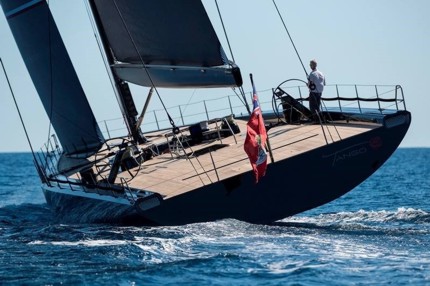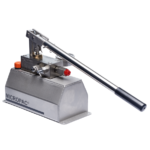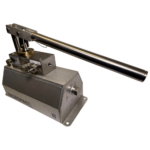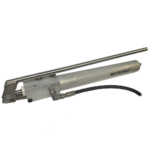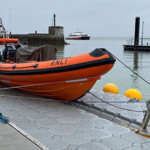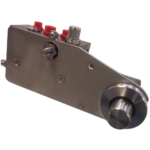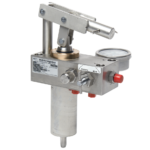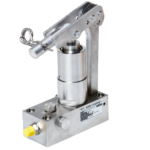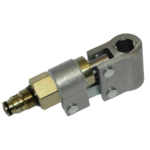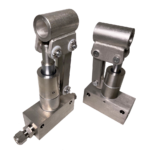Micropac rugged low corrosion hand pumps used worldwide for almost any marine application. Over 40 years of experience.
Marine and subsea hand pumps are used in the most punishing environments and are often safety critical. For example, subsea valve actuation pumps or a diving bell door pump just have to be rugged. Hand pumps are non- electric and either provide emergency standby for powered systems or power their own hydraulic system where manual hydraulics is the perfect simple solution. Every application is slightly different and has its own key requirements without compromise. After over 40 years of manufacturing our Micropac Marine and subsea hand pumps, we can offer our experience. Contact us to discuss your own application.
What might you need to know?
Why use a Micropac Hydraulic hand pump for a marine application?
You may need a manual backup in case of electrical failure. Our Micropac MT cartridge pumps are used worldwide on manifold based hydraulic systems to fit into a machined valve cavity. A component hydraulic hand pump or pump on reservoir can just be piped into an existing hydraulic system. Often the challenge is to offer a robust method of hydraulically switching over from powered operation to manual then back again.
You may have opted to keep a hydraulic system totally manual for standby and last resort circumstances. Or just a neat, low tech and cost effective solution. A lifeboat release on a merchant ship uses a Micropac PMP hand pump with integral reservoir to actuate a small cylinder which lifts the lifeboat onto its launch slide. It is a self contained simple hydraulic system that you need to work without fail after long periods. A diving bell door hydraulic hand pump is part of another simple system that must work without fail. Being able to handle rib inflatable craft and professional power craft on floating plastic docks can be simplified greatly by using corrosion resistant manual hydraulics. If you require dependability, don’t have power and simply won’t cope with the complexity and labour of ropes and blocks, manual hydraulics is your solution.
A simple manual system is invariably easier to protect from corrosion. The simplicity of design lends itself to low corrosion solutions. If 100% 316 stainless steel and polymer is your requirement, Micropac can offer this very cost effectively in our system builder PPS unit. Corrosion resistant electric hydraulic pumps are very exotic in comparison.
A manual system is inherently safe. It can be used in hazardous areas because it does not generate heat. In most cases, stop pumping and the system will stop moving. In marine lifting, handling and actuation systems, you need to be in control. Manual hydraulic pumps do offer this big safety benefit. For some users, a manual system is simply what they need for these safety reasons.
If you need a small sub-system running at higher pressure than a large powered system, the marine hand pump can provide this very cost effectively in addition to the lower pressure kit. Offshore wind farms use a high pressure Micropac marine hand pump to power hydraulics to remove the blades.
Micropac pumps are unique in offering materials combinations to provide the level of corrosion protection required for various budgets. For example, a subsea diving bell pump will require 100% 316 stainless.1.4404 and bronze external materials but a cartridge pump used on an offshore wind farm may use a 316 or 303 stainless pump body and hard anodized 6082T6 aluminium alloy handle mechanism parts for a light weight and cost effective pump. If you have over a hundred installed systems in one windfarm, the cost saving is significant. Contact us to discuss cost effective marine manual hydraulic solutions.
Do I need a 316 stainless 1.4404 hand pump?
Look at what has been specified or is required. Do you need very high corrosion resistance EXTERNALLY or do you need 100% 316 stainless steel 1.4404 WETTED PARTS? Some of our units use a 316 stainless body, barrel and other key components with other low corrosion materials like bronze. That combination is the norm unless somebody requires 100% 316 stainless. It comes down to the application and what a customer or specifier has asked for. External parts are in contact with the atmosphere or the water, with a “splash zone” being particularly punishing. Or you may be focused purely on the wetted parts in contact with the hydraulic fluid for specific reasons as detailed further on in this summary.
Is epoxy coating of a carbon steel pump an alternative to stainless steel?
Epoxy coating of carbon steel is very widely used in the offshore industry and in our experience only translates to hydraulics to an extent. Simply epoxy coating from a supplier such as Cromadex (amongst other suppliers) will work well on metal surfaces. These are two pack coatings that cure. You may struggle to mask off hydraulic components for blasting processes which provide the key and also masking for painting. Certainly, surface preparation has always seemed to us to be quite demanding for complex components. Degreasing solvent will easily damage seals. On a more basic level, you can’t paint a reciprocating part like a piston rod or a needle valve thread or spindle. We have never been sure about simplistic requirements to “epoxy coat a pump” for these reasons. For us, a better engineering alternative is to epoxy coat the pump body and barrel having fitted bronze bearing, 316 stainless piston rod and the hydraulic components then fit a 316 stainless handle mechanism once it comes back from the coatings contractor. This has worked well for many years as a sound compromise. That is just one solution, although moving to a stainless steel pump is often just easier.
Why would I require 100% 316 stainless 1.4404 wetted parts in a hydraulic system?
Some industries or users require 100% 316 stainless 1.4404 wetted parts simply to ensure that there is no risk of long term galvanic corrosion within the components of their system. In a complex system linked with pipework or hoses full of hydraulic fluid, galvanic corrosion can occur quite remotely. This is less of a problem with oil hydraulics as mineral oil doesn’t conduct electricity. Move to water, water-based fluids or glycols and this is a real risk. The nuclear industry is also very conscious of a hydraulic system failing due to galvanic corrosion.
The majority of our stainless 316 stainless hand pumps do not run with 100% 316 stainless 1.4404 yet provide a very low level of corrosion over many years. The wetted parts are largely 1.4404 316 stainless but add a bronze CW307G bearing and piston plus small amounts of stainless 302, 303, 304, 420 and 431. We wouldn’t make 100% 316 a requirement unless we had to. Our most widely used marine pump is supplied in the Offshore trim option which provides 100% 316 and bronze CW307G external parts. Generally, marine and offshore designers will think hard about mixing in 303, 304 and A2 stainless for external parts. There is invariably some corrosion which is both unsightly in the short term or a failure risk in the longer term.
What is special about a submersible hand pump?
Often, they are replacing a carbon steel hand pump. In reality “epoxy coating” of a carbon steel hand pump falls down where a carbon steel piston rod is left running in a steel bearing, pivot pins are still carbon steel and a needle valve spindle thread is steel in steel. There is no substitute for engineering these parts properly in subsea materials, although the argument of using carbon steel for a month or two until it seizes still seems to be tolerated.
The amount of fouling and corrosion will vary depending upon the location and depth. Often, equipment in a splash zone or only submerged some of the time will be most demanding on corrosion and pumps in shallow water most challenging on fouling. Some of our pumps are supplied with protective bellows over the piston rod to cut fouling but many customers don’t go down this route for various reasons.
Equipment deeper in the sea may be easier on corrosion if there is less oxygen, but other issues become important. Our reservoirs won’t be pressure vessels and will include a connection for a customer bladder type equalizer or accumulator to balance the pressure inside and outside the reservoir. These equalisers can themselves be expensive components. In reality, a diver won’t be able to generate massive hand loads, so we invariably specify smaller displacement pumps and lower handle loads. Also be aware that gloved hands will find it easier to operate quarter turn ball valve levers or larger handwheels rather than instrument knobs.
Our MGS Bell door and subsea pump is a basic submersible hand pump based on our 100% 316 stainless and bronze external wetted parts MG unit mounted on an integral 4 litre (2.5 litre in vertical mounting) reservoir. Extra reservoir bosses are fitted for easy connection of an equalizer and system components without the need for complex extra fittings.
What are the requirements of a hydraulic hand pump for a yacht?
Applications include MT cartridge pumps used in steering power packs, MW series used for lifting keels, superyacht swimming pool covers and bathing platforms plus our specialist MPP panel pump module built into centralised yacht cockpit hydraulic pumps for backstay tensioners, boom vangs and other auxiliaries. The PMP pump and specialist hydraulics for floating plastic rib docks are another yacht application to provide cost effective, low corrosion pumps for marine use.
Contact us to discuss your requirements.

